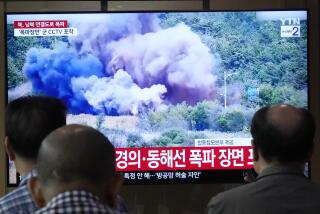North Korea rocket launch seen as successful
SEOUL â Despite earlier reports of technical difficulties, North Korea launched a long-range rocket Wednesday, and initial reports indicated that in this fourth attempt since 1998, the regime in Pyongyang successfully deployed a satellite into orbit.
If so, it would be a huge publicity coup for the new young leader, Kim Jong Un, and an embarrassment for rival South Korea, which has yet to establish a presence in space. The launch also caused some chagrin among intelligence analysts who were apparently misled by an announcement over the weekend that the missile launch would be delayed until later this month because of a technical glitch.
Pyongyang, which maintains that the rocket was intended to launch a satellite for peaceful scientific purposes, loudly trumpeted its success in a special broadcast on state television. A female announcer wearing a pink traditional Korean dress in front of a large North Korean flag read out a triumphant statement.
âThe Kwangmyongsong-3 [Shining Star-3] satellite has been successfully launched into the intended orbit path,â she said in a breathless voice that North Korean announcers usually reserved for the leadership.
The North American Aerospace Defense Command concurred with the report of an apparently successful launch. âInitial indications are that the missile deployed an object that appeared to achieve orbit,â it said in a statement.
North Koreans have insisted repeatedly that the rocket carries an Earth-observation satellite and that they are is merely exercising their right to peaceful activity in space. But the United States, the United Nations, South Korea and others suspect the North Korean program is a cover to test missile technology that could be used to target neighboring countries.
Military analysts note that the technology for launching satellites and warheads is virtually identical, involving the use of intercontinental ballistic missiles.
âThis could be a game-changer. The U.S. government needs to understand that its policy of benevolent neglect is not working,â said Andrei Lankov, a professor at South Koreaâs Kookmin University. âThe North Koreans will continue to develop their missile and nuclear technology and, eventually, whether it takes 10 years or 20, they will have a reliable ICBM with nuclear warheads.â
U.S. National Security Council spokesman Tommy Vietor called the launch âa highly provocative act,â adding in a statement that North Korea is âonly further isolating itself.â
âThis action is yet another example of North Koreaâs pattern of irresponsible behavior,â he said. âDevoting scarce resources to the development of ballistic missiles and nuclear weapons has not brought it security and acceptance by the international community â and never will.â
The rocket lifted off at 9:49 a.m. from the Sohae satellite launch station on North Koreaâs western coast. Aegis radar-equipped South Korean destroyers monitored it flying west of Okinawa over the East China Sea. Debris was found east of the Philippines, suggesting that the first stage of separation in the multistage launch had gone as planned.
North Korea had announced over the weekend that it was having problems with the rocket, and it extended a previously announced launch window to Dec. 29. Earlier reports based on satellite intelligence showed movements suggesting that the rocket was being disassembled for repairs.
âIt was very clever. This was probably a deliberate deception designed to get U.S., South Korean and Japanese agencies to move their tracking assets so that they would be caught with their guard down and collect less information,â said Daniel Pinkston, a Korea analyst with the International Crisis Group in Seoul.
North Koreaâs last attempt at launching a satellite earlier this year ended in humiliation, as the first stage disintegrated 70 miles from the launch site in the Yellow Sea, close enough to South Korea that its intelligence agencies were able to collect and analyze debris.
Pyongyang acknowledged in April that its launch had failed, but on previous occasions its propagandists have made elaborate claims of victory that proved false.
âWe will have to further study whether it was successful, but since the separated rockets have fallen at the expected locations, we have to leave open the possibility of success,â said Yang Moo-jin, a professor at the University of North Korean Studies in Seoul. âIf it is successful, North Korea would be one of 10 nations that have successfully launched a satellite into orbit on their own and have beat out South Korea in the space competition. They can use this to press the United States, as a long-range missile would have a possibility of reaching the U.S. mainland.â
Japan and South Korea condemned the missile launch as a violation of U.N. resolutions.
North Korea was particularly intent on launching the missile in 2012, the centennial of the birth of its founder, Kim Il Sung. For years, Pyongyangâs propagandists had been trumpeting 2012 as the deadline for North Korea to become a âstrong and prosperous nation.â The latest launch falls close to the anniversary of leader Kim Jong Ilâs death on Dec. 17, 2011, and ascension of his youngest son, Kim Jong Un, to power.
âTheir main motive is to showcase the achievements of the young leader and to use this achievement for domestic purposes, to show evidence of his loyalty to his father,â said Zhu Feng, an international affairs expert at Peking University.
The North Koreans also faced another deadline: the South Korean presidential election scheduled for Dec. 19. Pyongyang has a poor relationship with outgoing President Lee Myung-bak, and it favored having a missile launch under the South Korean leaderâs watch so as to start on a better foot with his successor.
Special correspondent Jung-yoon Choi in Seoul contributed to this report.
More to Read
Sign up for Essential California
The most important California stories and recommendations in your inbox every morning.
You may occasionally receive promotional content from the Los Angeles Times.










